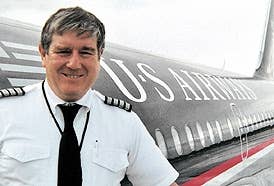
Captain Al Beerly has been one step behind the legendary Len Morgan since he started flying. Al reflects on Len's legacy, and what it's meant to him.
Cruising at Flight Level 370 in an Airbus 319, north of Dayton, Ohio, en route to Philadelphia, I begin to think about how I managed to realize a dream with the assistance of many fine people. For me, one of those people was a pilot-writer. When a pilot is an aviation writer, what is the likelihood that one reader will have his life directly touched and changed by that writer's literary output?
The answer to this hypothetical question began to unfold quite innocuously one afternoon in the latter part of the 1970s. In those days, I was a structural steel ironworker in Philadelphia. The job was difficult and almost always dangerous, but the money was good.
As I sorted through the mail that day, I quickly lost interest in the bills and other assorted junk mail. I opened up my copy of Flying and immediately noticed "Flying the Three Holer."
The author described the experience of flying a Boeing 727 in a manner that was interesting, exciting and easy to understand. His explanations of aircraft handling qualities were refreshingly unlike anything I had previously read.
I finished the article convinced that I, a mere commercial rated pilot and part-time flight instructor, could indeed fly a 727. From that day forward, Captain Len Morgan became a personal source of information, reading pleasure and encouragement. Captivated by his aeronautical and literary expertise, I always read his column first.
As the next several years unfolded, I instructed, flew charters, ferried airplanes, built my hours and read Captain Morgan's column. I'm not sure whether or not he realized that he was giving us wannabe airline pilots inside information when he wrote his column back then, but his sage advice was valuable and honest.
The course of my life changed one afternoon in 1981. An employee at Wings Airways informed me that the airline was in immediate need of a Britten-Norman Islander first officer. I had a difficult decision to make. Did I want to take an $18,000 pay cut and attempt to pursue a full-time career in aviation or did I want to remain where I was and not take the gamble?
I remembered an article Captain Morgan had written describing his thoughts when he was offered his first bona-fide flying position. He, too, once had a sacrifice and a decision to make. I accepted the sacrifice.
One month later, I was flying Islanders and Tri-Islanders in and out of Philadelphia International Airport and throughout southeastern Pennsylvania, New Jersey and Delaware. Sometimes I would see a Braniff Boeing 727 parked at the gate near our tiny Islanders. I often wondered if Captain Morgan was nearby and whether I might get a chance to fly the "three-holer."
Time passed quickly. In 1982, I became a Beech 99 first officer at Bar Harbor Airlines. In 1985, I entered the second officer training program at Piedmont Airlines as a flight engineer. During pilot orientation, I learned that Terry Morgan, Captain Len's son, was a member of the Piedmont pilot group. I eventually met him and even served as his first officer. I could not believe that I was flying with Captain Morgan's son in a Boeing 727, the very type of aircraft his father had written about years before.
In 1988, I once again found myself within Captain Morgan's sphere of influence. I had secured my first captain bid with Piedmont on the Fokker FK28. After ground school training, I headed to Tampa for simulator training. During my check ride debriefing, I learned that my examiner was none other than Captain Morgan's son-in-law, George.
It is one thing to read an author's words and quite another to step directly into that author's world, meet members of his family, and carry that experience with you throughout your career.
It happened to me. All I can possibly say is, "Thank you, Captain Morgan."

Sign-up for newsletters & special offers!
Get the latest FLYING stories & special offers delivered directly to your inbox






